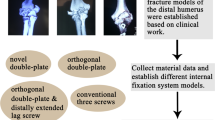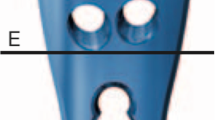Abstract
Purpose
A biomechanical study was performed to test the hypothesis that a new anatomically preformed, thinner, soft-tissue protecting plate system for distal humeral fractures (Tifix®-hybridplate [HP]) would show comparable results in the quasi-static and dynamic testings compared to two conventional implants: The 3.5-mm reconstruction plate (RP) providing primary stability with normal bone mineral density (BMD), and a multidirectional locking plate (Tifix®-plate [P]) which can be used with poor bone quality.
Methods
The Tifix®-HP was developed by the working group. The biomechanical testing was performed on a C2-fracture-model in 24 synthetic humeri. Three groups, each with eight bone-implant-constructs, were analysed in quasi-static and dynamic tests.
Results
The quasi-static measurements showed that under extension loading both locking plates (Tifix®-P, Tifix®-HP) were significantly stiffer than the reconstruction plate, and that the Tifix®-HP had a significantly lower stiffness than the two other implants under flexion loading. In the dynamic tests the Tifix®-P allowed significantly less fracture motion compared to the Tifix®-HP and the reconstruction plate. In an osteopaenic bone model locking plates failed only under much higher dynamic force than the reconstruction plate. The reconstruction plate and the Tifix®-P always failed through screw loosening, whereas the newly developed Tifix®-HP showed screw loosening in only one third of cases.
Conclusion
The hypothesis that the newly designed plate system showed comparable results in the quasi-static and dynamic tests compared to the conventional implants with a significantly lower implant volume and thickness was confirmed.





Similar content being viewed by others
References
Palvanen M, Kannus P, Parkkari J, Pitkäjärvi T, Pasanen M, Vuori I, Järvinen M (2000) The injury mechanisms of osteoporotic upper extremity fractures among older adults: a controlled study of 287 consecutive patients and their 108 controls. Osteoporos Int 11:822–831
Popovic D, King GJW (2012) Fragility fractures of the distal humerus: what is the optimal treatment? J Bone Joint Surg Br 94(1):16–22
Jupiter JB, Morrey BF (1993) Fractures of the distal humerus in the adult. In: Morrey BF (ed) The elbow and its disorders, 2nd edn. Saunders, Philadelphia, London, pp 328–366
Robinson CM, Hill RMF, Jacobs N, Dall G, Court-Brown CM (2003) Adult distal humeral metaphyseal fractures: epidemiology and results of treatment. J Orthop Trauma 17:38–47
Srinivasan K, Agarwal M, Matthews SJ, Giannoudis PV (2005) Fractures of the distal humerus in the elderly: is internal fixation the treatment of choice? Clin Orthop Relat Res 434:222–230
Bonnaire F, Bula P (2010) Distale humeral fractures. Trauma Berufskrankh 12(2 Suppl):96–103
Korner J, Diederichs G, Arzdorf M, Lill H, Josten C, Schneider E, Linke B (2004) A biomechanical evaluation of methods of distal humerus fracture fixation using locking compression plates versus conventional reconstruction plates. J Orthop Trauma 18:286–293
Windolf M, Maza ER, Gueorguiev B, Braunstein V, Schwieger K (2010) Treatment of distal humeral fractures using conventional implants. Biomechanical evaluation of a new implant configuration. BMC Musculoskelet Disord 11:172
Kollias CM, Darcy SP, Reed JG, Rosvold JM, Shrive NG, Hildebrand KA (2010) Distal humerus internal fixation: a biomechanical comparison of 90° and parallel constructs. Am J Orthop (Belle Mead NJ): 39(9):440–444
Penzkofer R, Hungerer S, Wipf F, von Oldenburg G, Augat P (2010) Anatomical plate configuration affects mechanical performance in distal humerus fractures. Clin Biomech (Bristol, Avon) 25(10):972–978
Schwartz A, Oka R, Odell T, Mahar A (2006) Biomechanical comparison of two different periarticular plating systems for stabilization of complex distal humerus fractures. Clin Biomech 21:950–955
Shin SJ, Sohn HS, Do NH (2010) A clinical comparison of two different double plating methods for intraarticular distal humerus fractures. J Should Elb Surg 19:2–9
Frattini M, Soncini G, Corradi M, Panno B, Tocco S, Pogliacomi F (2011) Mid-term results of complex distal humeral fractures. Musculoskelet Surg 95(3):205–213
Athwal GS, Hoxie SC, Rispoli DM, Steinmann SP (2009) Precontoured parallel plate fixation of AO/OTA type C distal humerus fractures. J Orthop Trauma 23:575–580
Dunlap JT, Chong AC, Lucas GL, Cooke FW (2008) Structural properties of a novel design of composite analogue humeri models. Ann Biomed Eng 36(11):1922–1926
Schuster I (2005) Development of a method to test osteosyntheses in intraarticular distal humeral fractures with a metaphyseal comminution zone in decreased bone mineral density. Dissertation, University of Freiburg, Germany
Morrey BF (1985) The elbow and its disorders. WB Saunders Co, Philadelphia, PA
Claes L, Wolf S, Augat P (2000) Mechanical modification of callus healing. Chirurg 71(9):989–994
Schuster I, Korner J, Arzdorf M, Schwieger K, Diederichs G, Linke B (2008) Mechanical comparison in cadaver specimens of three different 90-degree double-plate osteosyntheses for simulated C2-type distal humerus fractures with varying bone densities. J Orthop Trauma 22(2):113–120
Siebenlist S, Stöckle U, Lucke M (2009) Problems of osteoporotic fractures of the elbow. Obere Extremität 4:160–167
Nicol A, Berme N, Paul J (1977) A biomechanical analysis of elbow joint function. Joint replacement in the upper limb. Institution of Mechanical Engineers, London, pp 45–51
Nordin M (2001) Biomechanics of tendons and ligaments. In: Nordin M, Lorenz T (eds) Basic biomechanics of the musculoskeletal system, 3rd edn. Lippincott Williams & Wilkins, Philadelphia, pp 350–356
Rübberdt A, Surke C, Fuchs T, Frerichmann U, Matuszewski L, Vieth V, Raschke MJ (2008) Preformed plate-fixation system for type AO 13C3 distal humerus fractures: clinical experiences and treatment results taking access into account. Unfallchirurg 111(5): 308–322 [Article in German]
Conflict of interest
The authors declare that they have no conflict of interest.
Author information
Authors and Affiliations
Corresponding author
Rights and permissions
About this article
Cite this article
Voigt, C., Rank, C., Waizner, K. et al. Biomechanical testing of a new plate system for the distal humerus compared to two well-established implants. International Orthopaedics (SICOT) 37, 667–672 (2013). https://doi.org/10.1007/s00264-013-1779-7
Received:
Accepted:
Published:
Issue Date:
DOI: https://doi.org/10.1007/s00264-013-1779-7




